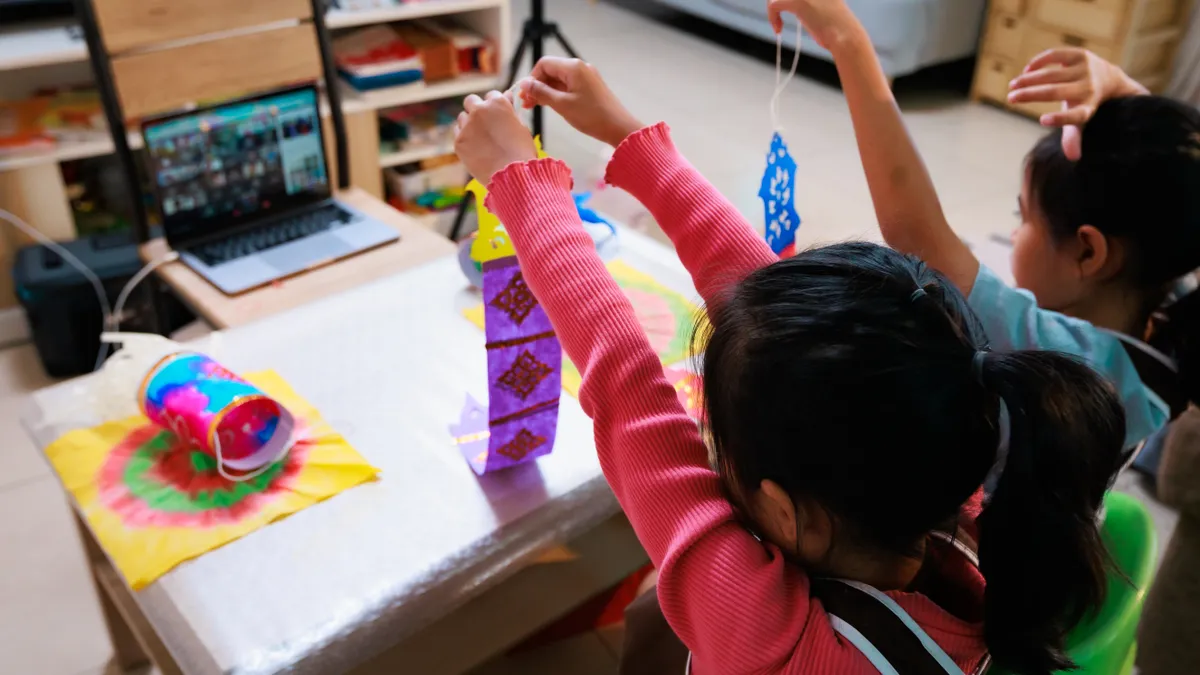Dive Brief:
- High-poverty students learning virtually during the 2020-21 school year were more likely to lack an appropriate workspace than their peers and also more likely to regularly fall behind academically, according to a U.S. Government Accountability Office report released Tuesday.
- The GAO report also found English learners more likely to struggle in accessing an appropriate place to work. EL students likewise faced more difficulties understanding lessons and completing assignments.
- Teachers surveyed for the GAO report shared that small, in-person group work and 1:1 check-ins between teacher and student were effective in helping EL students make academic progress. Those strategies — plus using physical instruction materials, tutoring during the school day and movement breaks — can also improve academic performance for all K-2 students, who were affected by certain learning obstacles more than older students, the report said.
Dive Insight:
The GAO report confirms many of the disparities researchers and district administrators have seen emerge from the shift to virtual learning during the pandemic.
The report found younger students significantly more likely to lack an appropriate workspace compared to their older peers among both EL and high-poverty students.
For the high-poverty students, those in K-5 were 23.3 times more likely to lack the needed area, while students in grades 6-8 were 9.8 times more likely and those in grades 9-12 were 6.2 times more likely to lack appropriate workspace, compared to their peers. For EL students, those in grades K-5 were 36.7 times more likely to lack needed workspace, compared to those in grades 6-8 who were 11.1 times more likely and those in 9-12 who were 9.3 times more likely.
The latest GAO research surveying 2,862 teachers marks the second of three reports looking to understand COVID-19’s impact on schools. The study gleaned data about high-poverty students from teachers who taught a majority of this group in a virtual environment for most of the 2020-21 school year. For the EL data, the report analyzed surveys from teachers who taught at least 20% of EL students through virtual learning.
The first report shared that 85% of teachers said live, in-person instruction improved student progress, compared to 56% who said live but virtual instruction helped with academic success.
Alicia Storey, an assistant superintendent at Westerly Public Schools in Rhode Island, said in an email her district carried out 1:1 check-ins between teachers and students as well as home visits during the pandemic to address students struggling with understanding or completing assignments.
While Storey said it was difficult to help students who lacked appropriate workspaces, she said her district distributed headsets with microphones for families with multiple students in a small space. Also, she said, students had the option to turn off their cameras during virtual instruction.
The district saw success when it provided tutoring to elementary students, Storey said, and it is continuing 1:1 teacher-student opportunities to help close achievement gaps.
“Making sure our vulnerable students feel like they belong and have strong relationships with their teachers (that the teachers know them well) was a priority for us,” Storey wrote. “Generally, I think, especially during the height of the pandemic in virtual learning, that the challenges that vulnerable student populations face on a daily basis were much more evident and exacerbated during the pandemic.”
The GAO report “affirms and adds more color to what we know,” said Matthew Kraft, an associate professor of education and economics at Brown University. The findings highlight strategies and lessons learned from the pandemic that can be integrated into in-person education practices moving forward, he said.
The mitigation strategies outlined in the report, such as in-school tutoring, movement breaks and small group work, should all be strongly considered as tools to better support students in an individualized, holistic way, Kraft said.
Knowing that teachers voiced support specifically for tutoring more students in school, he said, is “another affirming data point” in building research. Kraft further noted that in-person, high dosage tutoring is an effective learning model, particularly in addressing inequities.













